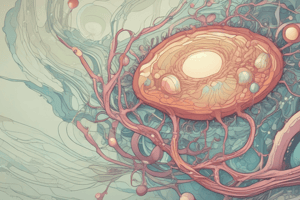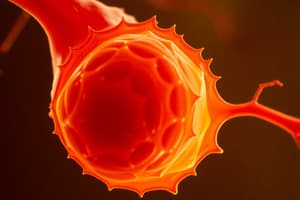Podcast
Questions and Answers
What role does GnRH play in the ovarian cycle?
What role does GnRH play in the ovarian cycle?
- It promotes the growth of the corpus luteum.
- It enhances the development of the primordial follicle.
- It stimulates the release of FSH and LH from the pituitary gland. (correct)
- It directly causes ovulation.
During which phase of the ovarian cycle does the surge of LH occur?
During which phase of the ovarian cycle does the surge of LH occur?
- Ovulatory phase (correct)
- Menstrual phase
- Luteal phase
- Follicular phase
Which hormone is primarily responsible for follicle maturation?
Which hormone is primarily responsible for follicle maturation?
- LH
- Progesterone
- Estrogen
- FSH (correct)
What is the correct sequence of follicular development leading up to ovulation?
What is the correct sequence of follicular development leading up to ovulation?
Which of the following is NOT a function of LH during the ovarian cycle?
Which of the following is NOT a function of LH during the ovarian cycle?
What describes the phenomenon where both maternal and placental blood spills occur during implantation?
What describes the phenomenon where both maternal and placental blood spills occur during implantation?
Which hormone is primarily responsible for stimulating increased production of LH during the maturation of vesicular follicles?
Which hormone is primarily responsible for stimulating increased production of LH during the maturation of vesicular follicles?
At what stage does an oocyte become arrested in meiosis II approximately 3 hours before ovulation?
At what stage does an oocyte become arrested in meiosis II approximately 3 hours before ovulation?
Which type of follicles develops independently of FSH according to the maturation sequence?
Which type of follicles develops independently of FSH according to the maturation sequence?
During which phase of the ovarian cycle does FSH recruit growing follicles into development?
During which phase of the ovarian cycle does FSH recruit growing follicles into development?
What type of follicle is characterized as vesicular or antral follicles?
What type of follicle is characterized as vesicular or antral follicles?
From which cells are estrogens produced during the maturation of follicles?
From which cells are estrogens produced during the maturation of follicles?
What is the first step in the maturation process of follicles during the ovarian cycle?
What is the first step in the maturation process of follicles during the ovarian cycle?
Which phase involves spermatozoa passing through the corona radiata barrier?
Which phase involves spermatozoa passing through the corona radiata barrier?
What occurs during phase 2 of oocyte penetration?
What occurs during phase 2 of oocyte penetration?
In which phase does a spermatozoon lose its plasma membrane?
In which phase does a spermatozoon lose its plasma membrane?
What is a necessary condition for sperm to fertilize an oocyte?
What is a necessary condition for sperm to fertilize an oocyte?
What structure is responsible for enabling spermatozoa to penetrate the zona pellucida?
What structure is responsible for enabling spermatozoa to penetrate the zona pellucida?
What happens to the remaining follicular cells after ovulation?
What happens to the remaining follicular cells after ovulation?
During which phase do the spermatozoa penetrate the membranes of the oocyte?
During which phase do the spermatozoa penetrate the membranes of the oocyte?
What is the effect of hypertrophy in the corpus luteum?
What is the effect of hypertrophy in the corpus luteum?
What role do fimbriae play in the reproductive process?
What role do fimbriae play in the reproductive process?
At what stage is the zona pellucida still present?
At what stage is the zona pellucida still present?
What hormone is produced by the developing blastocyst to maintain the corpus luteum?
What hormone is produced by the developing blastocyst to maintain the corpus luteum?
What is the correct sequence of development stages after fertilization?
What is the correct sequence of development stages after fertilization?
What does the inner cell mass of the blastocyst develop into?
What does the inner cell mass of the blastocyst develop into?
During which stage does the fluid enter the morula, leading to the formation of a blastocyst?
During which stage does the fluid enter the morula, leading to the formation of a blastocyst?
What occurs approximately 30 hours after fertilization?
What occurs approximately 30 hours after fertilization?
Which hormone is NOT involved in the preparation of the endometrium for implantation?
Which hormone is NOT involved in the preparation of the endometrium for implantation?
What is the primary hormone produced by the corpus luteum if conception occurs?
What is the primary hormone produced by the corpus luteum if conception occurs?
At which day of development does the human blastocyst begin to penetrate the uterine mucosa?
At which day of development does the human blastocyst begin to penetrate the uterine mucosa?
What happens to the corpus luteum if fertilization does not occur?
What happens to the corpus luteum if fertilization does not occur?
Which layers of the endometrium are affected by degeneration if conception does not occur?
Which layers of the endometrium are affected by degeneration if conception does not occur?
What initiates the secretory phase of the endometrium during pregnancy?
What initiates the secretory phase of the endometrium during pregnancy?
Which structure provides blood vessels to the basal layer of the endometrium?
Which structure provides blood vessels to the basal layer of the endometrium?
What is the consequence of the absence of fertilization at the end of the menstrual cycle?
What is the consequence of the absence of fertilization at the end of the menstrual cycle?
Which type of cells comprises the inner cell mass of the blastocyst?
Which type of cells comprises the inner cell mass of the blastocyst?
Study Notes
Developmental Biology Overview
- Formation of extraembryonic membranes is crucial during early development, leading to the creation of two key cavities: chorionic cavity and amniotic cavity.
- The hypothalamus releases GnRH, prompting the pituitary gland to secrete gonadotropins such as FSH (Follicle Stimulating Hormone) and LH (Luteinizing Hormone).
- FSH stimulates primordial follicles to grow and mature, while LH triggers ovulation by surging in concentration.
- After ovulation, LH supports the development of the corpus luteum, essential for maintaining pregnancy.
Follicular Development
- Development stages of follicles include primordial, growing, vesicular (antral), and mature vesicular (Graafian) stages.
- Primordial follicles exist initially, but some develop independently into growing follicles.
- FSH also recruits growing follicles to transition into vesicular follicles, supported by estrogen production from the follicular and thecal cells.
- The mature follicle undergoes meiosis I and enters meiosis II, pausing in metaphase before ovulation.
Fertilization Phases
- Three critical phases of fertilization:
- Penetration of the corona radiata.
- Penetration of the zona pellucida.
- Penetration of the oocyte membrane by a sperm cell after it undergoes capacitation.
Early Embryonic Development
- Zygote development follows fertilization:
- The two-cell stage occurs about 30 hours post-fertilization.
- Four-cell stage at 40 hours and the 12-16 cell stage at approximately 3 days.
- The late morula stage is reached by day 4, with blastomeres enclosed by the zona pellucida, which disintegrates at the end of day 4.
Implantation Process
- Following fertilization, embryoblasts form the inner cell mass, which will develop into the embryo, while trophoblasts create the outer layer.
- By the sixth day, the human blastocyst begins penetrating the uterine mucosa for implantation.
- Successful implantation prompts the blastocyst to produce human chorionic gonadotropin (HCG), which preserves the corpus luteum and sustains progesterone levels, crucial for maintaining the pregnancy environment in the endometrium.
Menstrual Cycle and Fertility
- If no fertilization occurs, the corpus luteum degenerates, leading to menstruation, where the basal layer of the endometrium also sheds due to lack of progesterone support.
- In case of conception, progesterone and HCG levels remain elevated, influencing the uterine environment and resulting in the continuation of the secretory phase of the endometrium.
Studying That Suits You
Use AI to generate personalized quizzes and flashcards to suit your learning preferences.
Related Documents
Description
Explore the crucial processes in developmental biology, with a focus on the formation of extraembryonic membranes and the hormonal regulation of follicles. This quiz covers the stages of follicular development and the roles of key hormones such as FSH and LH in reproduction. Test your knowledge on these essential biological concepts.




